Effective Business Communications: Diagnostic Report and Action Plan
VerifiedAdded on 2020/05/28
|30
|7668
|30
Report
AI Summary
This report presents a comprehensive self-assessment of the student's business communication skills. It begins with an introduction highlighting the importance of effective communication and outlines the report's objectives. The core of the report involves the application of five communication diagnostic tools: the Self-Perceived Communication Competence scale (SPCC), Personal report of Intercultural Communication Apprehension (PRICA), Non-Verbal Immediacy Scale-Self report, Personal report of Public Speaking Anxiety (PRPSA), and Talkaholic Scale. The report then analyzes the findings from these tools, identifying two key communication issues: low self-confidence in face-to-face interactions and introversion. A literature review explores these issues, examining theoretical perspectives and communication models. Finally, an action plan is proposed, detailing specific steps and timelines to address the identified weaknesses and enhance overall communication effectiveness. The report concludes with a summary of the findings and recommendations.
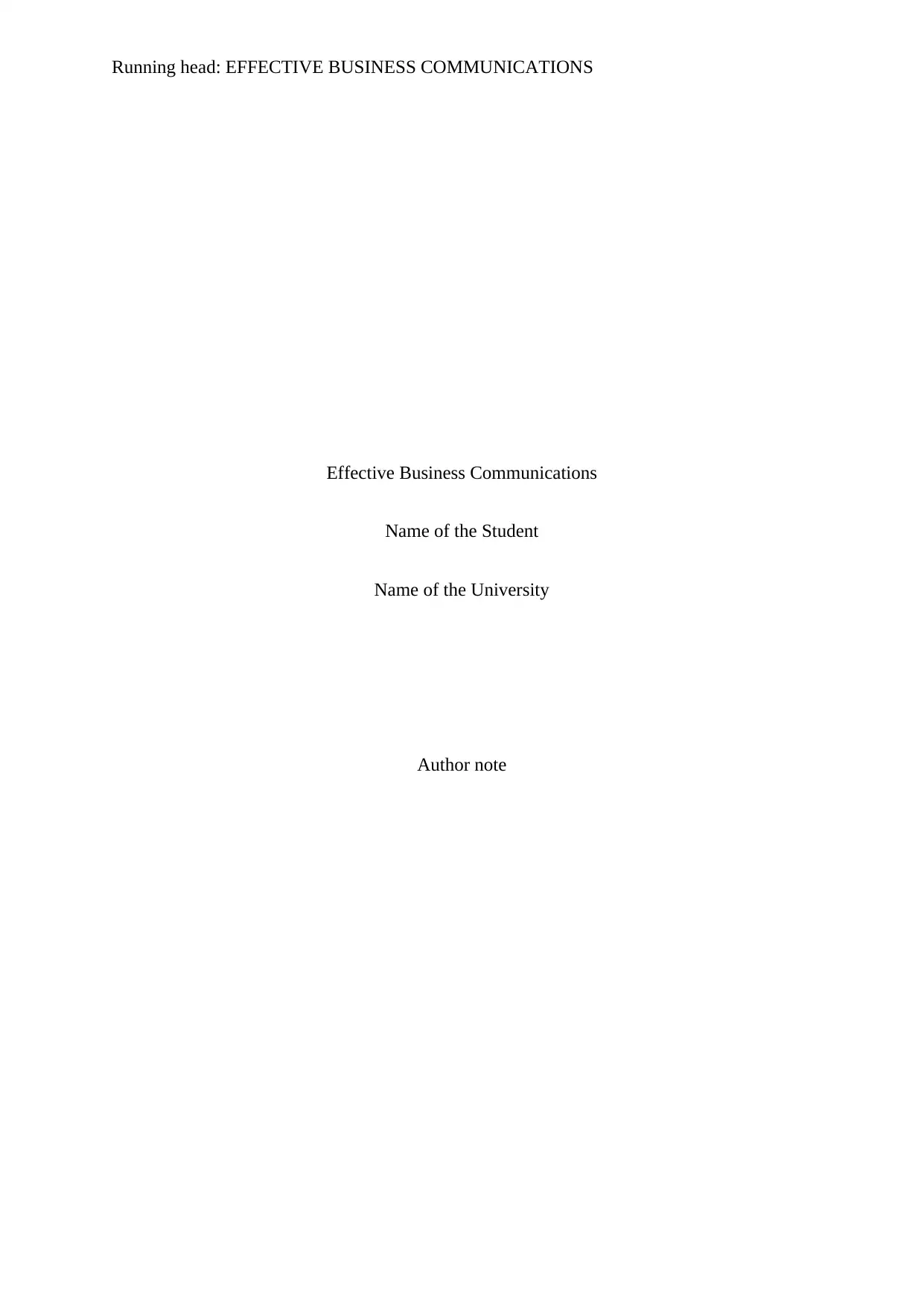
Running head: EFFECTIVE BUSINESS COMMUNICATIONS
Effective Business Communications
Name of the Student
Name of the University
Author note
Effective Business Communications
Name of the Student
Name of the University
Author note
Paraphrase This Document
Need a fresh take? Get an instant paraphrase of this document with our AI Paraphraser
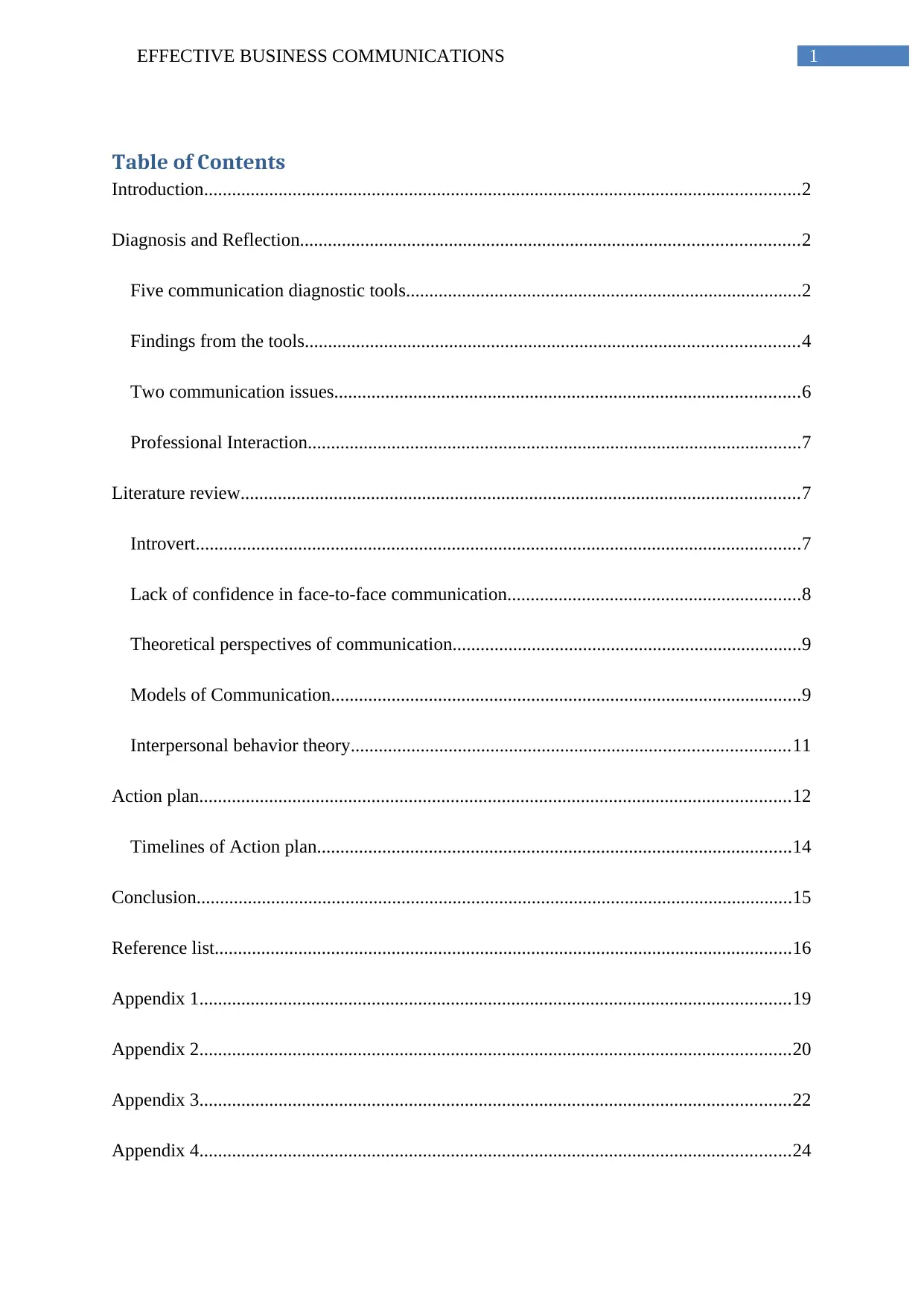
1EFFECTIVE BUSINESS COMMUNICATIONS
Table of Contents
Introduction................................................................................................................................2
Diagnosis and Reflection...........................................................................................................2
Five communication diagnostic tools.....................................................................................2
Findings from the tools..........................................................................................................4
Two communication issues....................................................................................................6
Professional Interaction..........................................................................................................7
Literature review........................................................................................................................7
Introvert..................................................................................................................................7
Lack of confidence in face-to-face communication...............................................................8
Theoretical perspectives of communication...........................................................................9
Models of Communication.....................................................................................................9
Interpersonal behavior theory..............................................................................................11
Action plan...............................................................................................................................12
Timelines of Action plan......................................................................................................14
Conclusion................................................................................................................................15
Reference list............................................................................................................................16
Appendix 1...............................................................................................................................19
Appendix 2...............................................................................................................................20
Appendix 3...............................................................................................................................22
Appendix 4...............................................................................................................................24
Table of Contents
Introduction................................................................................................................................2
Diagnosis and Reflection...........................................................................................................2
Five communication diagnostic tools.....................................................................................2
Findings from the tools..........................................................................................................4
Two communication issues....................................................................................................6
Professional Interaction..........................................................................................................7
Literature review........................................................................................................................7
Introvert..................................................................................................................................7
Lack of confidence in face-to-face communication...............................................................8
Theoretical perspectives of communication...........................................................................9
Models of Communication.....................................................................................................9
Interpersonal behavior theory..............................................................................................11
Action plan...............................................................................................................................12
Timelines of Action plan......................................................................................................14
Conclusion................................................................................................................................15
Reference list............................................................................................................................16
Appendix 1...............................................................................................................................19
Appendix 2...............................................................................................................................20
Appendix 3...............................................................................................................................22
Appendix 4...............................................................................................................................24
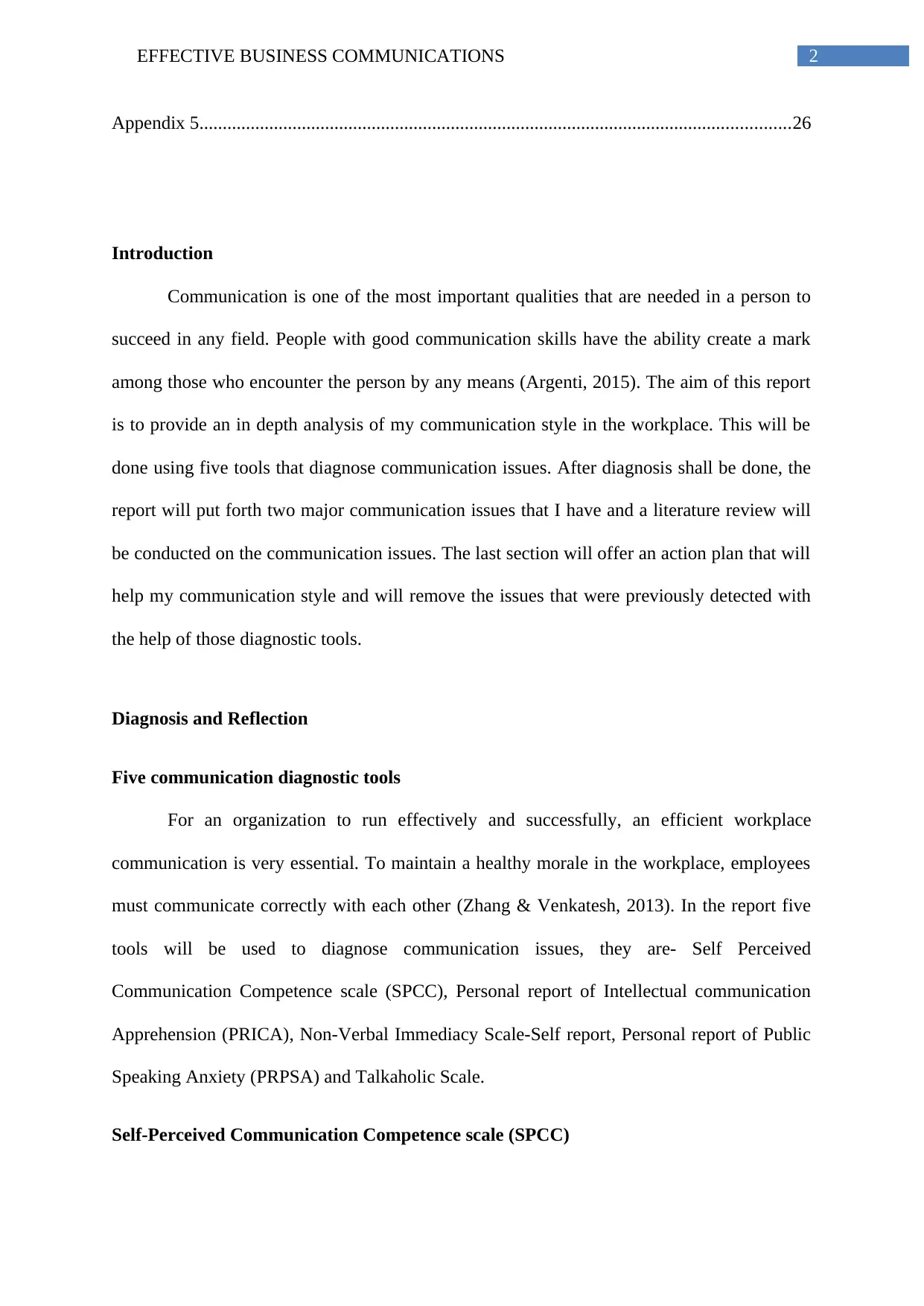
2EFFECTIVE BUSINESS COMMUNICATIONS
Appendix 5...............................................................................................................................26
Introduction
Communication is one of the most important qualities that are needed in a person to
succeed in any field. People with good communication skills have the ability create a mark
among those who encounter the person by any means (Argenti, 2015). The aim of this report
is to provide an in depth analysis of my communication style in the workplace. This will be
done using five tools that diagnose communication issues. After diagnosis shall be done, the
report will put forth two major communication issues that I have and a literature review will
be conducted on the communication issues. The last section will offer an action plan that will
help my communication style and will remove the issues that were previously detected with
the help of those diagnostic tools.
Diagnosis and Reflection
Five communication diagnostic tools
For an organization to run effectively and successfully, an efficient workplace
communication is very essential. To maintain a healthy morale in the workplace, employees
must communicate correctly with each other (Zhang & Venkatesh, 2013). In the report five
tools will be used to diagnose communication issues, they are- Self Perceived
Communication Competence scale (SPCC), Personal report of Intellectual communication
Apprehension (PRICA), Non-Verbal Immediacy Scale-Self report, Personal report of Public
Speaking Anxiety (PRPSA) and Talkaholic Scale.
Self-Perceived Communication Competence scale (SPCC)
Appendix 5...............................................................................................................................26
Introduction
Communication is one of the most important qualities that are needed in a person to
succeed in any field. People with good communication skills have the ability create a mark
among those who encounter the person by any means (Argenti, 2015). The aim of this report
is to provide an in depth analysis of my communication style in the workplace. This will be
done using five tools that diagnose communication issues. After diagnosis shall be done, the
report will put forth two major communication issues that I have and a literature review will
be conducted on the communication issues. The last section will offer an action plan that will
help my communication style and will remove the issues that were previously detected with
the help of those diagnostic tools.
Diagnosis and Reflection
Five communication diagnostic tools
For an organization to run effectively and successfully, an efficient workplace
communication is very essential. To maintain a healthy morale in the workplace, employees
must communicate correctly with each other (Zhang & Venkatesh, 2013). In the report five
tools will be used to diagnose communication issues, they are- Self Perceived
Communication Competence scale (SPCC), Personal report of Intellectual communication
Apprehension (PRICA), Non-Verbal Immediacy Scale-Self report, Personal report of Public
Speaking Anxiety (PRPSA) and Talkaholic Scale.
Self-Perceived Communication Competence scale (SPCC)
⊘ This is a preview!⊘
Do you want full access?
Subscribe today to unlock all pages.

Trusted by 1+ million students worldwide
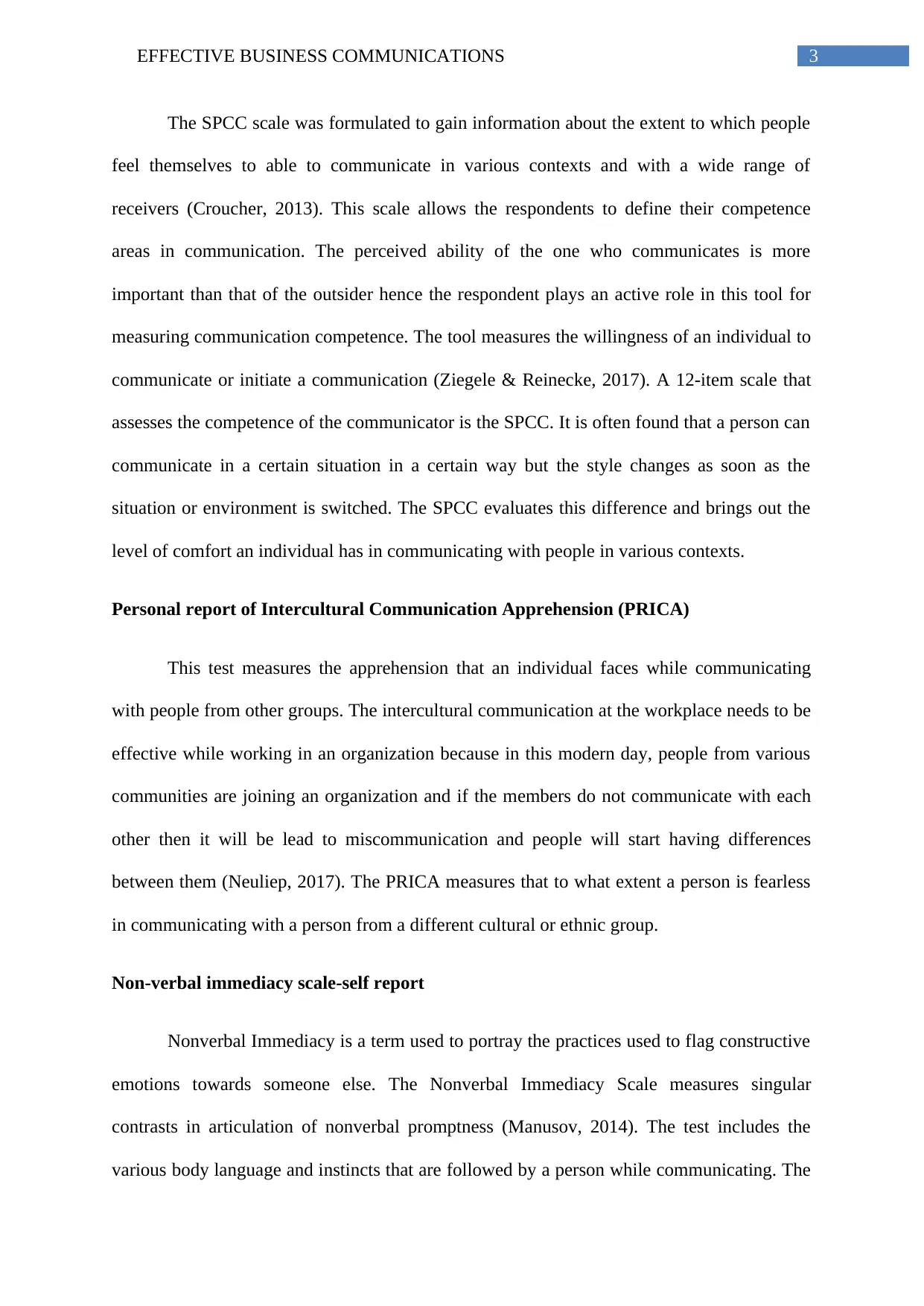
3EFFECTIVE BUSINESS COMMUNICATIONS
The SPCC scale was formulated to gain information about the extent to which people
feel themselves to able to communicate in various contexts and with a wide range of
receivers (Croucher, 2013). This scale allows the respondents to define their competence
areas in communication. The perceived ability of the one who communicates is more
important than that of the outsider hence the respondent plays an active role in this tool for
measuring communication competence. The tool measures the willingness of an individual to
communicate or initiate a communication (Ziegele & Reinecke, 2017). A 12-item scale that
assesses the competence of the communicator is the SPCC. It is often found that a person can
communicate in a certain situation in a certain way but the style changes as soon as the
situation or environment is switched. The SPCC evaluates this difference and brings out the
level of comfort an individual has in communicating with people in various contexts.
Personal report of Intercultural Communication Apprehension (PRICA)
This test measures the apprehension that an individual faces while communicating
with people from other groups. The intercultural communication at the workplace needs to be
effective while working in an organization because in this modern day, people from various
communities are joining an organization and if the members do not communicate with each
other then it will be lead to miscommunication and people will start having differences
between them (Neuliep, 2017). The PRICA measures that to what extent a person is fearless
in communicating with a person from a different cultural or ethnic group.
Non-verbal immediacy scale-self report
Nonverbal Immediacy is a term used to portray the practices used to flag constructive
emotions towards someone else. The Nonverbal Immediacy Scale measures singular
contrasts in articulation of nonverbal promptness (Manusov, 2014). The test includes the
various body language and instincts that are followed by a person while communicating. The
The SPCC scale was formulated to gain information about the extent to which people
feel themselves to able to communicate in various contexts and with a wide range of
receivers (Croucher, 2013). This scale allows the respondents to define their competence
areas in communication. The perceived ability of the one who communicates is more
important than that of the outsider hence the respondent plays an active role in this tool for
measuring communication competence. The tool measures the willingness of an individual to
communicate or initiate a communication (Ziegele & Reinecke, 2017). A 12-item scale that
assesses the competence of the communicator is the SPCC. It is often found that a person can
communicate in a certain situation in a certain way but the style changes as soon as the
situation or environment is switched. The SPCC evaluates this difference and brings out the
level of comfort an individual has in communicating with people in various contexts.
Personal report of Intercultural Communication Apprehension (PRICA)
This test measures the apprehension that an individual faces while communicating
with people from other groups. The intercultural communication at the workplace needs to be
effective while working in an organization because in this modern day, people from various
communities are joining an organization and if the members do not communicate with each
other then it will be lead to miscommunication and people will start having differences
between them (Neuliep, 2017). The PRICA measures that to what extent a person is fearless
in communicating with a person from a different cultural or ethnic group.
Non-verbal immediacy scale-self report
Nonverbal Immediacy is a term used to portray the practices used to flag constructive
emotions towards someone else. The Nonverbal Immediacy Scale measures singular
contrasts in articulation of nonverbal promptness (Manusov, 2014). The test includes the
various body language and instincts that are followed by a person while communicating. The
Paraphrase This Document
Need a fresh take? Get an instant paraphrase of this document with our AI Paraphraser
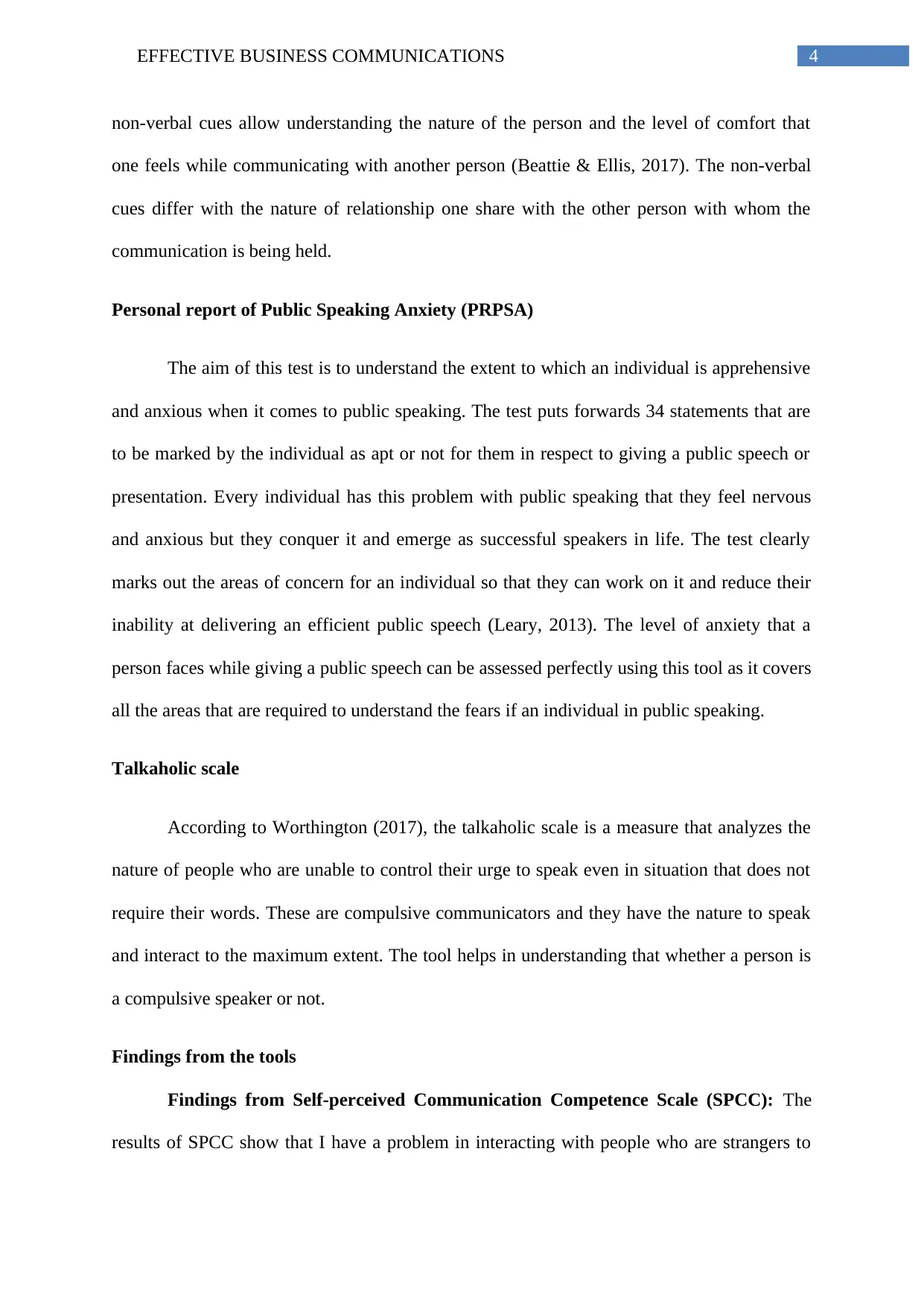
4EFFECTIVE BUSINESS COMMUNICATIONS
non-verbal cues allow understanding the nature of the person and the level of comfort that
one feels while communicating with another person (Beattie & Ellis, 2017). The non-verbal
cues differ with the nature of relationship one share with the other person with whom the
communication is being held.
Personal report of Public Speaking Anxiety (PRPSA)
The aim of this test is to understand the extent to which an individual is apprehensive
and anxious when it comes to public speaking. The test puts forwards 34 statements that are
to be marked by the individual as apt or not for them in respect to giving a public speech or
presentation. Every individual has this problem with public speaking that they feel nervous
and anxious but they conquer it and emerge as successful speakers in life. The test clearly
marks out the areas of concern for an individual so that they can work on it and reduce their
inability at delivering an efficient public speech (Leary, 2013). The level of anxiety that a
person faces while giving a public speech can be assessed perfectly using this tool as it covers
all the areas that are required to understand the fears if an individual in public speaking.
Talkaholic scale
According to Worthington (2017), the talkaholic scale is a measure that analyzes the
nature of people who are unable to control their urge to speak even in situation that does not
require their words. These are compulsive communicators and they have the nature to speak
and interact to the maximum extent. The tool helps in understanding that whether a person is
a compulsive speaker or not.
Findings from the tools
Findings from Self-perceived Communication Competence Scale (SPCC): The
results of SPCC show that I have a problem in interacting with people who are strangers to
non-verbal cues allow understanding the nature of the person and the level of comfort that
one feels while communicating with another person (Beattie & Ellis, 2017). The non-verbal
cues differ with the nature of relationship one share with the other person with whom the
communication is being held.
Personal report of Public Speaking Anxiety (PRPSA)
The aim of this test is to understand the extent to which an individual is apprehensive
and anxious when it comes to public speaking. The test puts forwards 34 statements that are
to be marked by the individual as apt or not for them in respect to giving a public speech or
presentation. Every individual has this problem with public speaking that they feel nervous
and anxious but they conquer it and emerge as successful speakers in life. The test clearly
marks out the areas of concern for an individual so that they can work on it and reduce their
inability at delivering an efficient public speech (Leary, 2013). The level of anxiety that a
person faces while giving a public speech can be assessed perfectly using this tool as it covers
all the areas that are required to understand the fears if an individual in public speaking.
Talkaholic scale
According to Worthington (2017), the talkaholic scale is a measure that analyzes the
nature of people who are unable to control their urge to speak even in situation that does not
require their words. These are compulsive communicators and they have the nature to speak
and interact to the maximum extent. The tool helps in understanding that whether a person is
a compulsive speaker or not.
Findings from the tools
Findings from Self-perceived Communication Competence Scale (SPCC): The
results of SPCC show that I have a problem in interacting with people who are strangers to
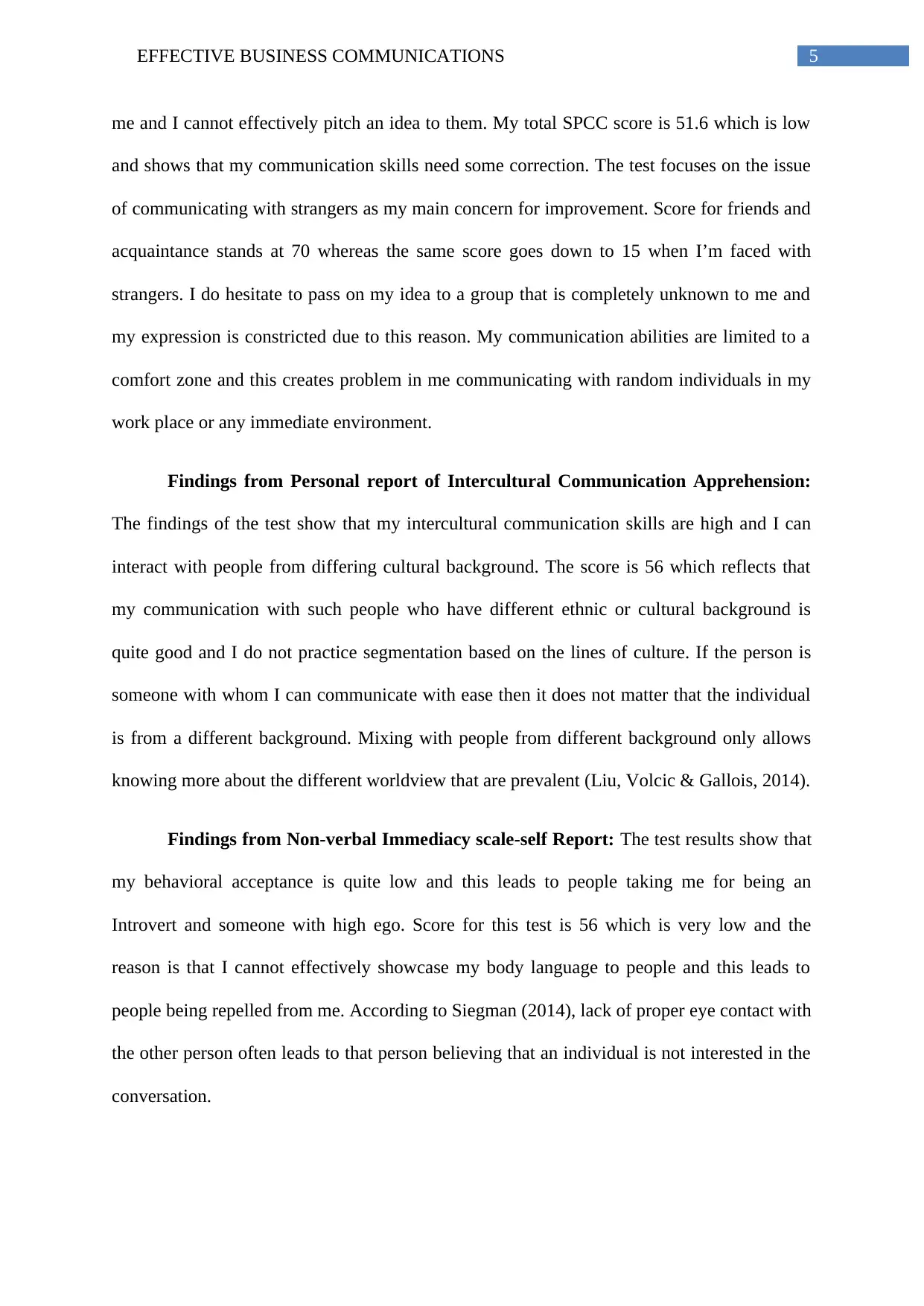
5EFFECTIVE BUSINESS COMMUNICATIONS
me and I cannot effectively pitch an idea to them. My total SPCC score is 51.6 which is low
and shows that my communication skills need some correction. The test focuses on the issue
of communicating with strangers as my main concern for improvement. Score for friends and
acquaintance stands at 70 whereas the same score goes down to 15 when I’m faced with
strangers. I do hesitate to pass on my idea to a group that is completely unknown to me and
my expression is constricted due to this reason. My communication abilities are limited to a
comfort zone and this creates problem in me communicating with random individuals in my
work place or any immediate environment.
Findings from Personal report of Intercultural Communication Apprehension:
The findings of the test show that my intercultural communication skills are high and I can
interact with people from differing cultural background. The score is 56 which reflects that
my communication with such people who have different ethnic or cultural background is
quite good and I do not practice segmentation based on the lines of culture. If the person is
someone with whom I can communicate with ease then it does not matter that the individual
is from a different background. Mixing with people from different background only allows
knowing more about the different worldview that are prevalent (Liu, Volcic & Gallois, 2014).
Findings from Non-verbal Immediacy scale-self Report: The test results show that
my behavioral acceptance is quite low and this leads to people taking me for being an
Introvert and someone with high ego. Score for this test is 56 which is very low and the
reason is that I cannot effectively showcase my body language to people and this leads to
people being repelled from me. According to Siegman (2014), lack of proper eye contact with
the other person often leads to that person believing that an individual is not interested in the
conversation.
me and I cannot effectively pitch an idea to them. My total SPCC score is 51.6 which is low
and shows that my communication skills need some correction. The test focuses on the issue
of communicating with strangers as my main concern for improvement. Score for friends and
acquaintance stands at 70 whereas the same score goes down to 15 when I’m faced with
strangers. I do hesitate to pass on my idea to a group that is completely unknown to me and
my expression is constricted due to this reason. My communication abilities are limited to a
comfort zone and this creates problem in me communicating with random individuals in my
work place or any immediate environment.
Findings from Personal report of Intercultural Communication Apprehension:
The findings of the test show that my intercultural communication skills are high and I can
interact with people from differing cultural background. The score is 56 which reflects that
my communication with such people who have different ethnic or cultural background is
quite good and I do not practice segmentation based on the lines of culture. If the person is
someone with whom I can communicate with ease then it does not matter that the individual
is from a different background. Mixing with people from different background only allows
knowing more about the different worldview that are prevalent (Liu, Volcic & Gallois, 2014).
Findings from Non-verbal Immediacy scale-self Report: The test results show that
my behavioral acceptance is quite low and this leads to people taking me for being an
Introvert and someone with high ego. Score for this test is 56 which is very low and the
reason is that I cannot effectively showcase my body language to people and this leads to
people being repelled from me. According to Siegman (2014), lack of proper eye contact with
the other person often leads to that person believing that an individual is not interested in the
conversation.
⊘ This is a preview!⊘
Do you want full access?
Subscribe today to unlock all pages.

Trusted by 1+ million students worldwide
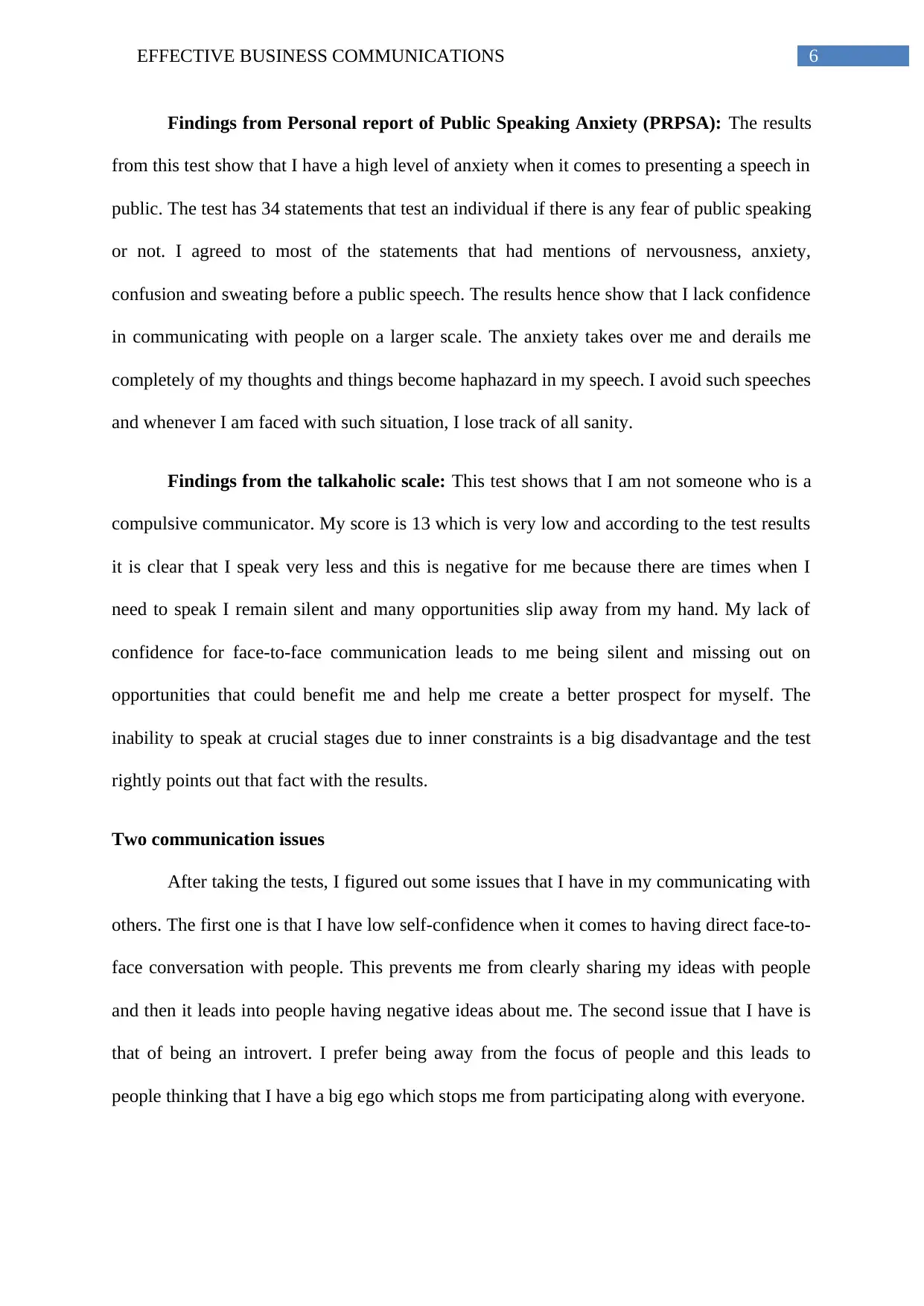
6EFFECTIVE BUSINESS COMMUNICATIONS
Findings from Personal report of Public Speaking Anxiety (PRPSA): The results
from this test show that I have a high level of anxiety when it comes to presenting a speech in
public. The test has 34 statements that test an individual if there is any fear of public speaking
or not. I agreed to most of the statements that had mentions of nervousness, anxiety,
confusion and sweating before a public speech. The results hence show that I lack confidence
in communicating with people on a larger scale. The anxiety takes over me and derails me
completely of my thoughts and things become haphazard in my speech. I avoid such speeches
and whenever I am faced with such situation, I lose track of all sanity.
Findings from the talkaholic scale: This test shows that I am not someone who is a
compulsive communicator. My score is 13 which is very low and according to the test results
it is clear that I speak very less and this is negative for me because there are times when I
need to speak I remain silent and many opportunities slip away from my hand. My lack of
confidence for face-to-face communication leads to me being silent and missing out on
opportunities that could benefit me and help me create a better prospect for myself. The
inability to speak at crucial stages due to inner constraints is a big disadvantage and the test
rightly points out that fact with the results.
Two communication issues
After taking the tests, I figured out some issues that I have in my communicating with
others. The first one is that I have low self-confidence when it comes to having direct face-to-
face conversation with people. This prevents me from clearly sharing my ideas with people
and then it leads into people having negative ideas about me. The second issue that I have is
that of being an introvert. I prefer being away from the focus of people and this leads to
people thinking that I have a big ego which stops me from participating along with everyone.
Findings from Personal report of Public Speaking Anxiety (PRPSA): The results
from this test show that I have a high level of anxiety when it comes to presenting a speech in
public. The test has 34 statements that test an individual if there is any fear of public speaking
or not. I agreed to most of the statements that had mentions of nervousness, anxiety,
confusion and sweating before a public speech. The results hence show that I lack confidence
in communicating with people on a larger scale. The anxiety takes over me and derails me
completely of my thoughts and things become haphazard in my speech. I avoid such speeches
and whenever I am faced with such situation, I lose track of all sanity.
Findings from the talkaholic scale: This test shows that I am not someone who is a
compulsive communicator. My score is 13 which is very low and according to the test results
it is clear that I speak very less and this is negative for me because there are times when I
need to speak I remain silent and many opportunities slip away from my hand. My lack of
confidence for face-to-face communication leads to me being silent and missing out on
opportunities that could benefit me and help me create a better prospect for myself. The
inability to speak at crucial stages due to inner constraints is a big disadvantage and the test
rightly points out that fact with the results.
Two communication issues
After taking the tests, I figured out some issues that I have in my communicating with
others. The first one is that I have low self-confidence when it comes to having direct face-to-
face conversation with people. This prevents me from clearly sharing my ideas with people
and then it leads into people having negative ideas about me. The second issue that I have is
that of being an introvert. I prefer being away from the focus of people and this leads to
people thinking that I have a big ego which stops me from participating along with everyone.
Paraphrase This Document
Need a fresh take? Get an instant paraphrase of this document with our AI Paraphraser
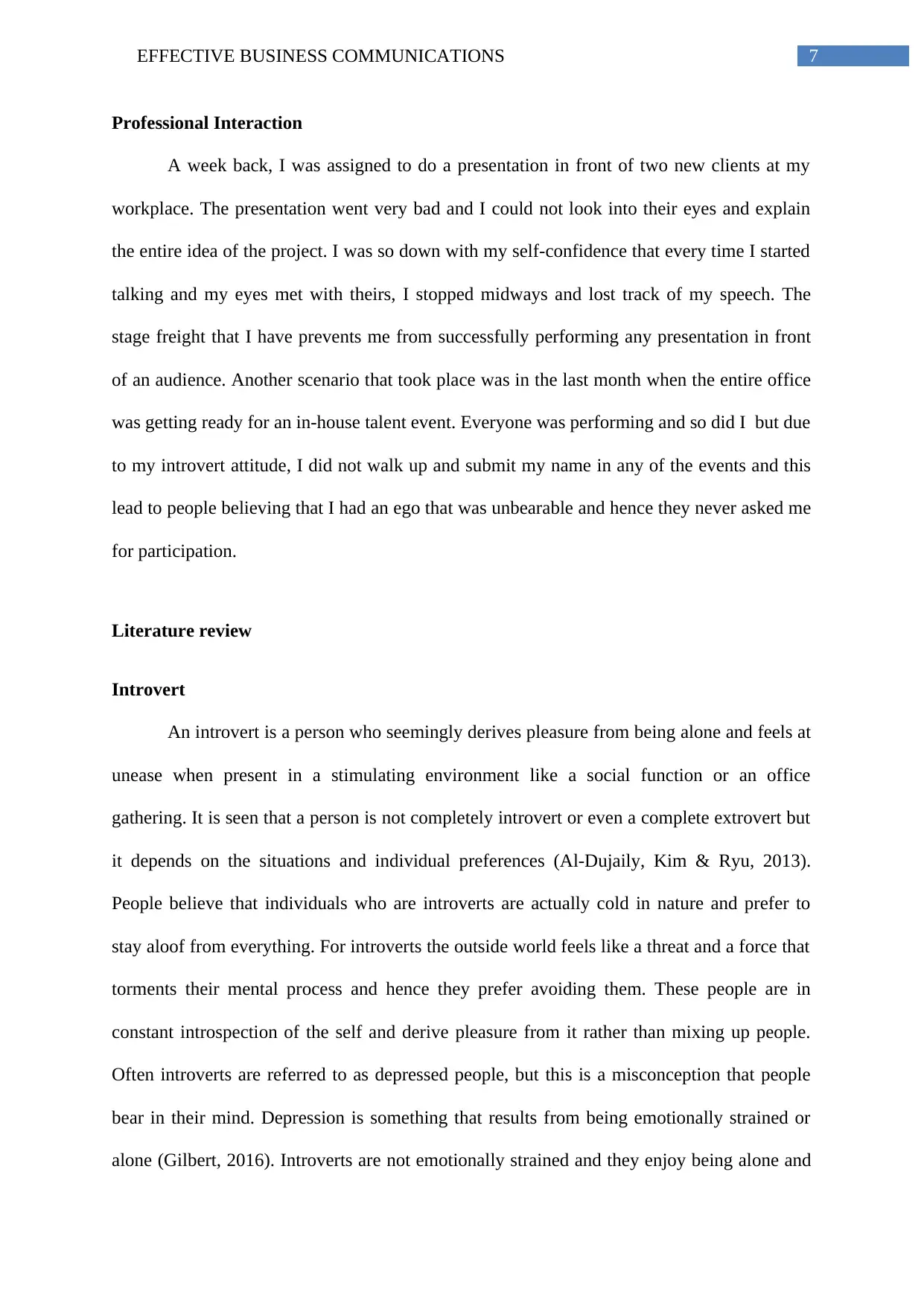
7EFFECTIVE BUSINESS COMMUNICATIONS
Professional Interaction
A week back, I was assigned to do a presentation in front of two new clients at my
workplace. The presentation went very bad and I could not look into their eyes and explain
the entire idea of the project. I was so down with my self-confidence that every time I started
talking and my eyes met with theirs, I stopped midways and lost track of my speech. The
stage freight that I have prevents me from successfully performing any presentation in front
of an audience. Another scenario that took place was in the last month when the entire office
was getting ready for an in-house talent event. Everyone was performing and so did I but due
to my introvert attitude, I did not walk up and submit my name in any of the events and this
lead to people believing that I had an ego that was unbearable and hence they never asked me
for participation.
Literature review
Introvert
An introvert is a person who seemingly derives pleasure from being alone and feels at
unease when present in a stimulating environment like a social function or an office
gathering. It is seen that a person is not completely introvert or even a complete extrovert but
it depends on the situations and individual preferences (Al-Dujaily, Kim & Ryu, 2013).
People believe that individuals who are introverts are actually cold in nature and prefer to
stay aloof from everything. For introverts the outside world feels like a threat and a force that
torments their mental process and hence they prefer avoiding them. These people are in
constant introspection of the self and derive pleasure from it rather than mixing up people.
Often introverts are referred to as depressed people, but this is a misconception that people
bear in their mind. Depression is something that results from being emotionally strained or
alone (Gilbert, 2016). Introverts are not emotionally strained and they enjoy being alone and
Professional Interaction
A week back, I was assigned to do a presentation in front of two new clients at my
workplace. The presentation went very bad and I could not look into their eyes and explain
the entire idea of the project. I was so down with my self-confidence that every time I started
talking and my eyes met with theirs, I stopped midways and lost track of my speech. The
stage freight that I have prevents me from successfully performing any presentation in front
of an audience. Another scenario that took place was in the last month when the entire office
was getting ready for an in-house talent event. Everyone was performing and so did I but due
to my introvert attitude, I did not walk up and submit my name in any of the events and this
lead to people believing that I had an ego that was unbearable and hence they never asked me
for participation.
Literature review
Introvert
An introvert is a person who seemingly derives pleasure from being alone and feels at
unease when present in a stimulating environment like a social function or an office
gathering. It is seen that a person is not completely introvert or even a complete extrovert but
it depends on the situations and individual preferences (Al-Dujaily, Kim & Ryu, 2013).
People believe that individuals who are introverts are actually cold in nature and prefer to
stay aloof from everything. For introverts the outside world feels like a threat and a force that
torments their mental process and hence they prefer avoiding them. These people are in
constant introspection of the self and derive pleasure from it rather than mixing up people.
Often introverts are referred to as depressed people, but this is a misconception that people
bear in their mind. Depression is something that results from being emotionally strained or
alone (Gilbert, 2016). Introverts are not emotionally strained and they enjoy being alone and
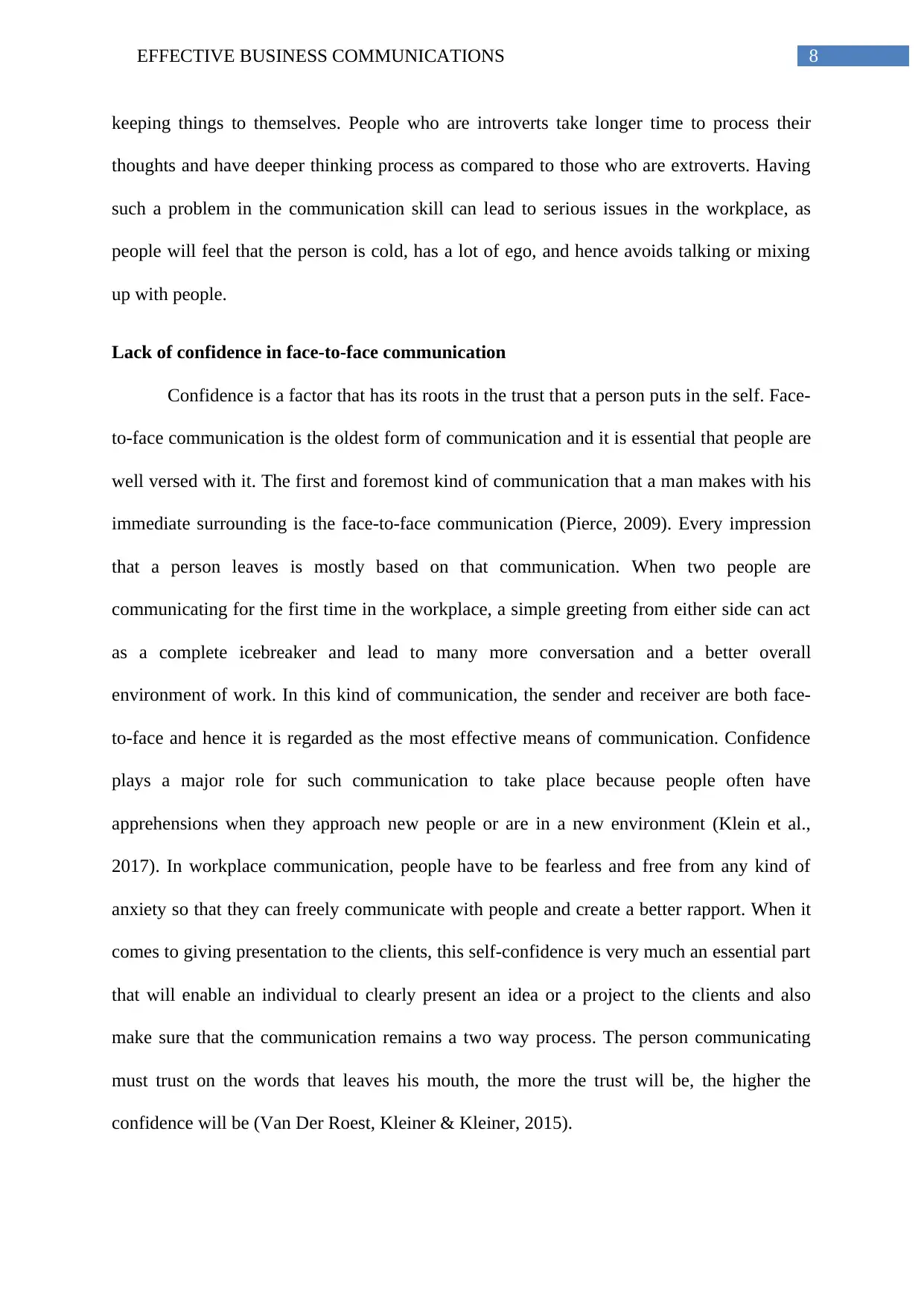
8EFFECTIVE BUSINESS COMMUNICATIONS
keeping things to themselves. People who are introverts take longer time to process their
thoughts and have deeper thinking process as compared to those who are extroverts. Having
such a problem in the communication skill can lead to serious issues in the workplace, as
people will feel that the person is cold, has a lot of ego, and hence avoids talking or mixing
up with people.
Lack of confidence in face-to-face communication
Confidence is a factor that has its roots in the trust that a person puts in the self. Face-
to-face communication is the oldest form of communication and it is essential that people are
well versed with it. The first and foremost kind of communication that a man makes with his
immediate surrounding is the face-to-face communication (Pierce, 2009). Every impression
that a person leaves is mostly based on that communication. When two people are
communicating for the first time in the workplace, a simple greeting from either side can act
as a complete icebreaker and lead to many more conversation and a better overall
environment of work. In this kind of communication, the sender and receiver are both face-
to-face and hence it is regarded as the most effective means of communication. Confidence
plays a major role for such communication to take place because people often have
apprehensions when they approach new people or are in a new environment (Klein et al.,
2017). In workplace communication, people have to be fearless and free from any kind of
anxiety so that they can freely communicate with people and create a better rapport. When it
comes to giving presentation to the clients, this self-confidence is very much an essential part
that will enable an individual to clearly present an idea or a project to the clients and also
make sure that the communication remains a two way process. The person communicating
must trust on the words that leaves his mouth, the more the trust will be, the higher the
confidence will be (Van Der Roest, Kleiner & Kleiner, 2015).
keeping things to themselves. People who are introverts take longer time to process their
thoughts and have deeper thinking process as compared to those who are extroverts. Having
such a problem in the communication skill can lead to serious issues in the workplace, as
people will feel that the person is cold, has a lot of ego, and hence avoids talking or mixing
up with people.
Lack of confidence in face-to-face communication
Confidence is a factor that has its roots in the trust that a person puts in the self. Face-
to-face communication is the oldest form of communication and it is essential that people are
well versed with it. The first and foremost kind of communication that a man makes with his
immediate surrounding is the face-to-face communication (Pierce, 2009). Every impression
that a person leaves is mostly based on that communication. When two people are
communicating for the first time in the workplace, a simple greeting from either side can act
as a complete icebreaker and lead to many more conversation and a better overall
environment of work. In this kind of communication, the sender and receiver are both face-
to-face and hence it is regarded as the most effective means of communication. Confidence
plays a major role for such communication to take place because people often have
apprehensions when they approach new people or are in a new environment (Klein et al.,
2017). In workplace communication, people have to be fearless and free from any kind of
anxiety so that they can freely communicate with people and create a better rapport. When it
comes to giving presentation to the clients, this self-confidence is very much an essential part
that will enable an individual to clearly present an idea or a project to the clients and also
make sure that the communication remains a two way process. The person communicating
must trust on the words that leaves his mouth, the more the trust will be, the higher the
confidence will be (Van Der Roest, Kleiner & Kleiner, 2015).
⊘ This is a preview!⊘
Do you want full access?
Subscribe today to unlock all pages.

Trusted by 1+ million students worldwide
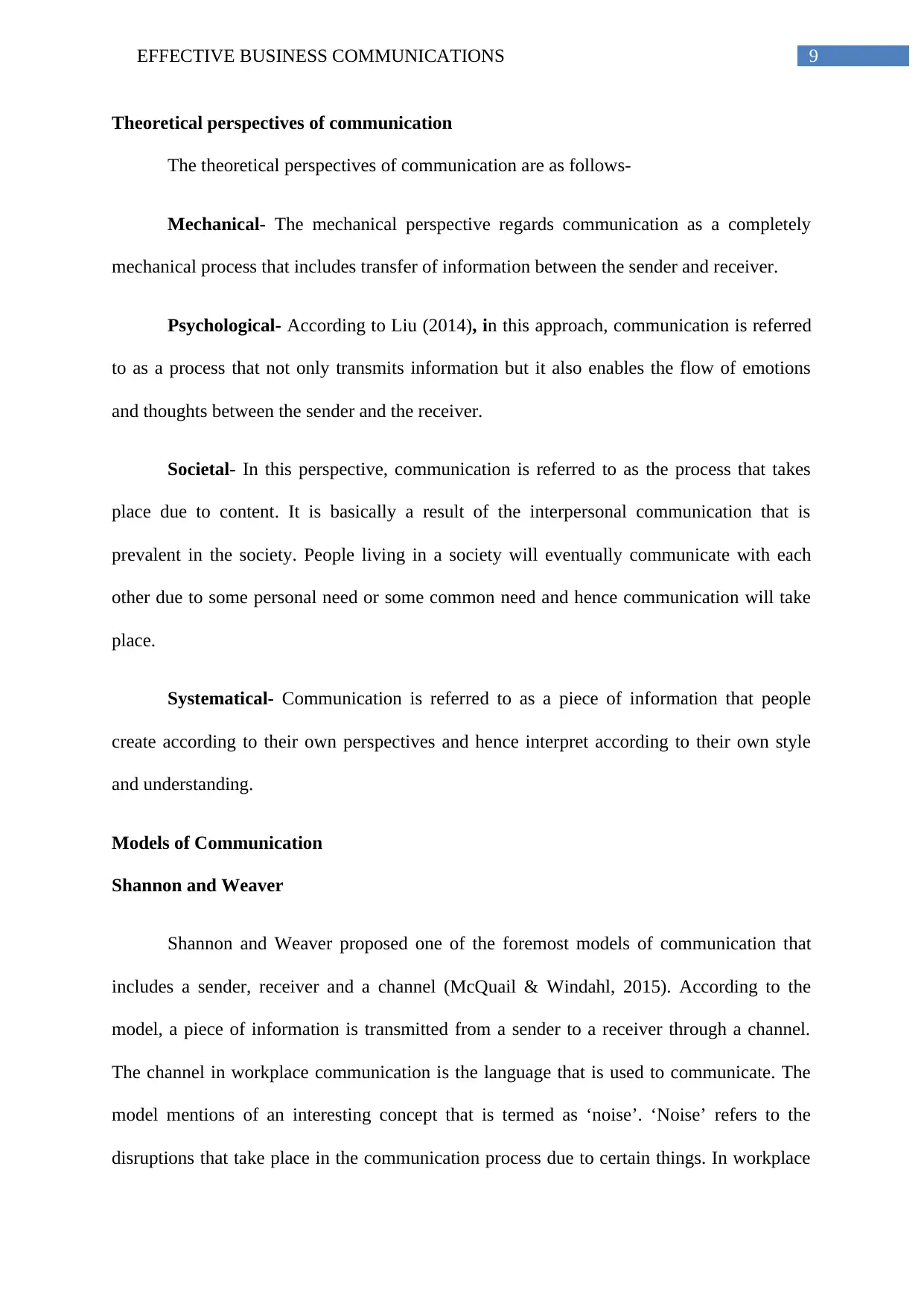
9EFFECTIVE BUSINESS COMMUNICATIONS
Theoretical perspectives of communication
The theoretical perspectives of communication are as follows-
Mechanical- The mechanical perspective regards communication as a completely
mechanical process that includes transfer of information between the sender and receiver.
Psychological- According to Liu (2014), in this approach, communication is referred
to as a process that not only transmits information but it also enables the flow of emotions
and thoughts between the sender and the receiver.
Societal- In this perspective, communication is referred to as the process that takes
place due to content. It is basically a result of the interpersonal communication that is
prevalent in the society. People living in a society will eventually communicate with each
other due to some personal need or some common need and hence communication will take
place.
Systematical- Communication is referred to as a piece of information that people
create according to their own perspectives and hence interpret according to their own style
and understanding.
Models of Communication
Shannon and Weaver
Shannon and Weaver proposed one of the foremost models of communication that
includes a sender, receiver and a channel (McQuail & Windahl, 2015). According to the
model, a piece of information is transmitted from a sender to a receiver through a channel.
The channel in workplace communication is the language that is used to communicate. The
model mentions of an interesting concept that is termed as ‘noise’. ‘Noise’ refers to the
disruptions that take place in the communication process due to certain things. In workplace
Theoretical perspectives of communication
The theoretical perspectives of communication are as follows-
Mechanical- The mechanical perspective regards communication as a completely
mechanical process that includes transfer of information between the sender and receiver.
Psychological- According to Liu (2014), in this approach, communication is referred
to as a process that not only transmits information but it also enables the flow of emotions
and thoughts between the sender and the receiver.
Societal- In this perspective, communication is referred to as the process that takes
place due to content. It is basically a result of the interpersonal communication that is
prevalent in the society. People living in a society will eventually communicate with each
other due to some personal need or some common need and hence communication will take
place.
Systematical- Communication is referred to as a piece of information that people
create according to their own perspectives and hence interpret according to their own style
and understanding.
Models of Communication
Shannon and Weaver
Shannon and Weaver proposed one of the foremost models of communication that
includes a sender, receiver and a channel (McQuail & Windahl, 2015). According to the
model, a piece of information is transmitted from a sender to a receiver through a channel.
The channel in workplace communication is the language that is used to communicate. The
model mentions of an interesting concept that is termed as ‘noise’. ‘Noise’ refers to the
disruptions that take place in the communication process due to certain things. In workplace
Paraphrase This Document
Need a fresh take? Get an instant paraphrase of this document with our AI Paraphraser
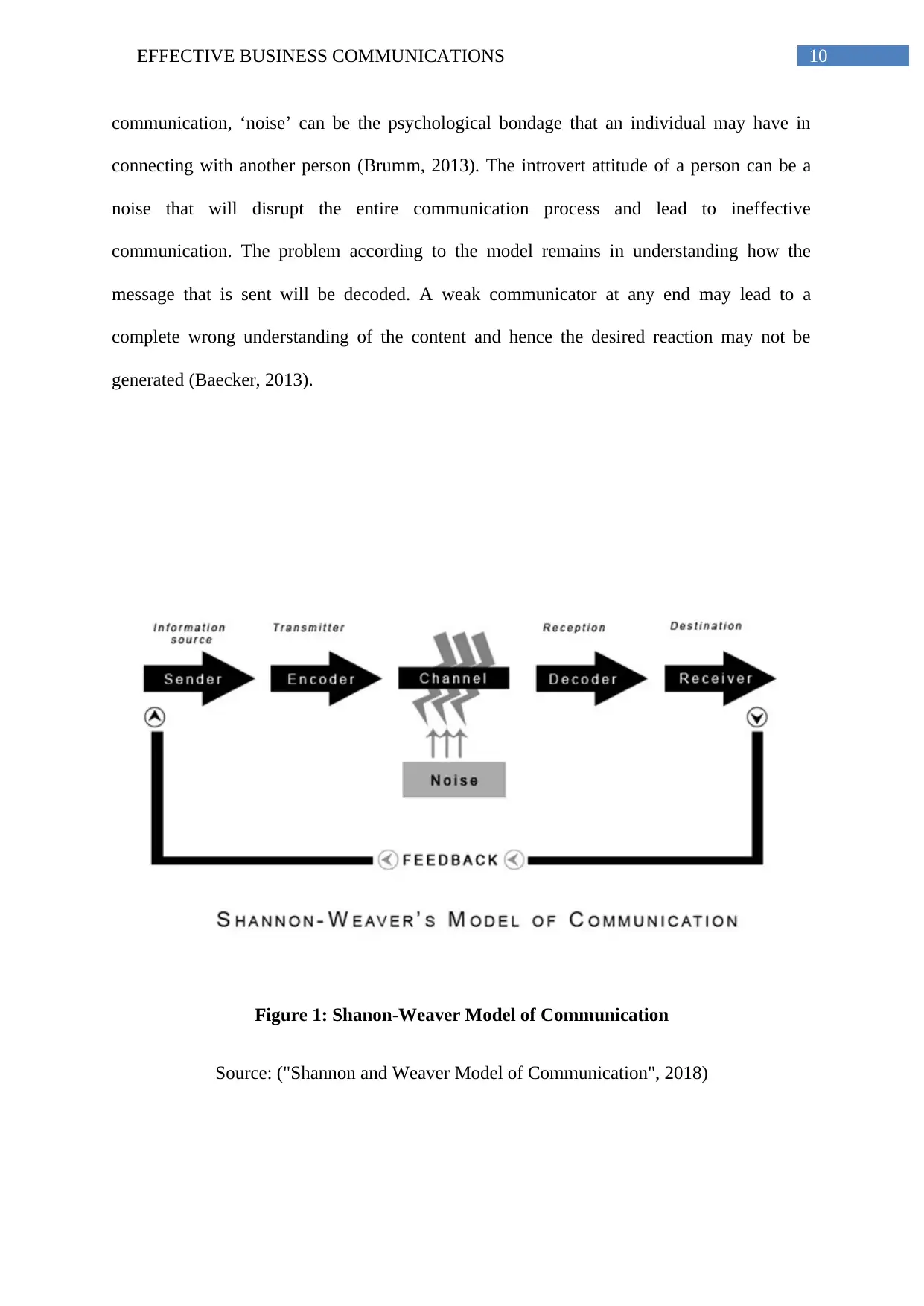
10EFFECTIVE BUSINESS COMMUNICATIONS
communication, ‘noise’ can be the psychological bondage that an individual may have in
connecting with another person (Brumm, 2013). The introvert attitude of a person can be a
noise that will disrupt the entire communication process and lead to ineffective
communication. The problem according to the model remains in understanding how the
message that is sent will be decoded. A weak communicator at any end may lead to a
complete wrong understanding of the content and hence the desired reaction may not be
generated (Baecker, 2013).
Figure 1: Shanon-Weaver Model of Communication
Source: ("Shannon and Weaver Model of Communication", 2018)
communication, ‘noise’ can be the psychological bondage that an individual may have in
connecting with another person (Brumm, 2013). The introvert attitude of a person can be a
noise that will disrupt the entire communication process and lead to ineffective
communication. The problem according to the model remains in understanding how the
message that is sent will be decoded. A weak communicator at any end may lead to a
complete wrong understanding of the content and hence the desired reaction may not be
generated (Baecker, 2013).
Figure 1: Shanon-Weaver Model of Communication
Source: ("Shannon and Weaver Model of Communication", 2018)
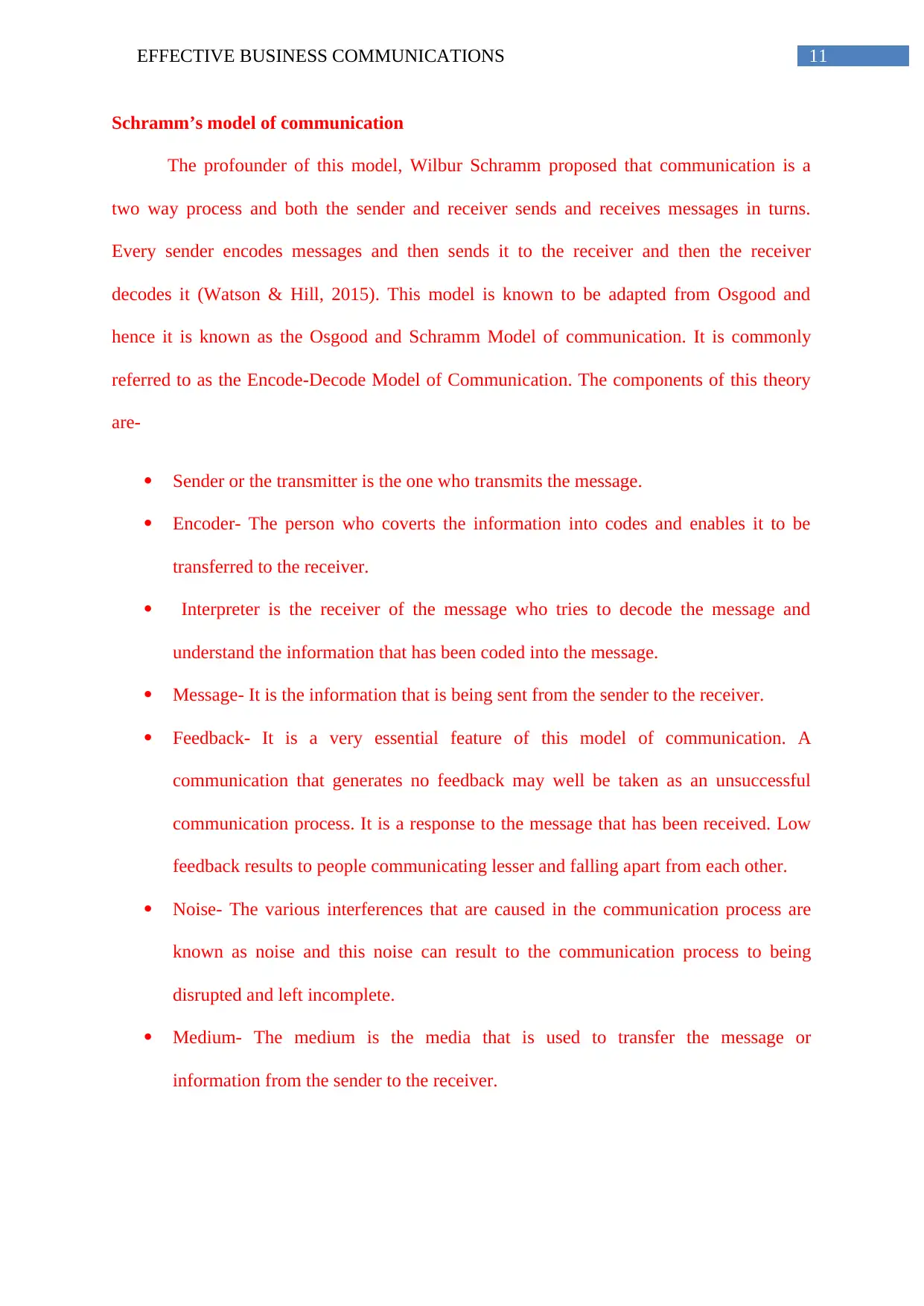
11EFFECTIVE BUSINESS COMMUNICATIONS
Schramm’s model of communication
The profounder of this model, Wilbur Schramm proposed that communication is a
two way process and both the sender and receiver sends and receives messages in turns.
Every sender encodes messages and then sends it to the receiver and then the receiver
decodes it (Watson & Hill, 2015). This model is known to be adapted from Osgood and
hence it is known as the Osgood and Schramm Model of communication. It is commonly
referred to as the Encode-Decode Model of Communication. The components of this theory
are-
Sender or the transmitter is the one who transmits the message.
Encoder- The person who coverts the information into codes and enables it to be
transferred to the receiver.
Interpreter is the receiver of the message who tries to decode the message and
understand the information that has been coded into the message.
Message- It is the information that is being sent from the sender to the receiver.
Feedback- It is a very essential feature of this model of communication. A
communication that generates no feedback may well be taken as an unsuccessful
communication process. It is a response to the message that has been received. Low
feedback results to people communicating lesser and falling apart from each other.
Noise- The various interferences that are caused in the communication process are
known as noise and this noise can result to the communication process to being
disrupted and left incomplete.
Medium- The medium is the media that is used to transfer the message or
information from the sender to the receiver.
Schramm’s model of communication
The profounder of this model, Wilbur Schramm proposed that communication is a
two way process and both the sender and receiver sends and receives messages in turns.
Every sender encodes messages and then sends it to the receiver and then the receiver
decodes it (Watson & Hill, 2015). This model is known to be adapted from Osgood and
hence it is known as the Osgood and Schramm Model of communication. It is commonly
referred to as the Encode-Decode Model of Communication. The components of this theory
are-
Sender or the transmitter is the one who transmits the message.
Encoder- The person who coverts the information into codes and enables it to be
transferred to the receiver.
Interpreter is the receiver of the message who tries to decode the message and
understand the information that has been coded into the message.
Message- It is the information that is being sent from the sender to the receiver.
Feedback- It is a very essential feature of this model of communication. A
communication that generates no feedback may well be taken as an unsuccessful
communication process. It is a response to the message that has been received. Low
feedback results to people communicating lesser and falling apart from each other.
Noise- The various interferences that are caused in the communication process are
known as noise and this noise can result to the communication process to being
disrupted and left incomplete.
Medium- The medium is the media that is used to transfer the message or
information from the sender to the receiver.
⊘ This is a preview!⊘
Do you want full access?
Subscribe today to unlock all pages.

Trusted by 1+ million students worldwide
1 out of 30
Related Documents
Your All-in-One AI-Powered Toolkit for Academic Success.
+13062052269
info@desklib.com
Available 24*7 on WhatsApp / Email
![[object Object]](/_next/static/media/star-bottom.7253800d.svg)
Unlock your academic potential
Copyright © 2020–2025 A2Z Services. All Rights Reserved. Developed and managed by ZUCOL.




